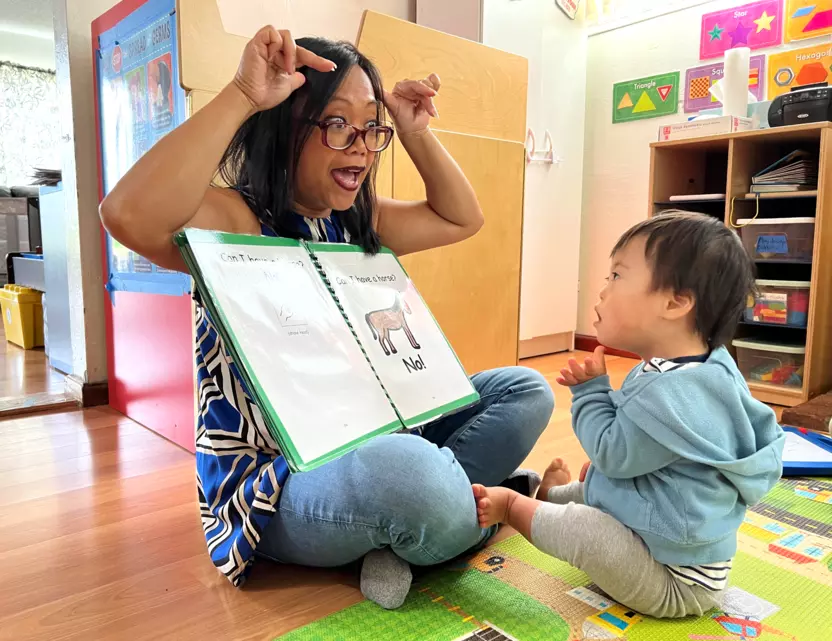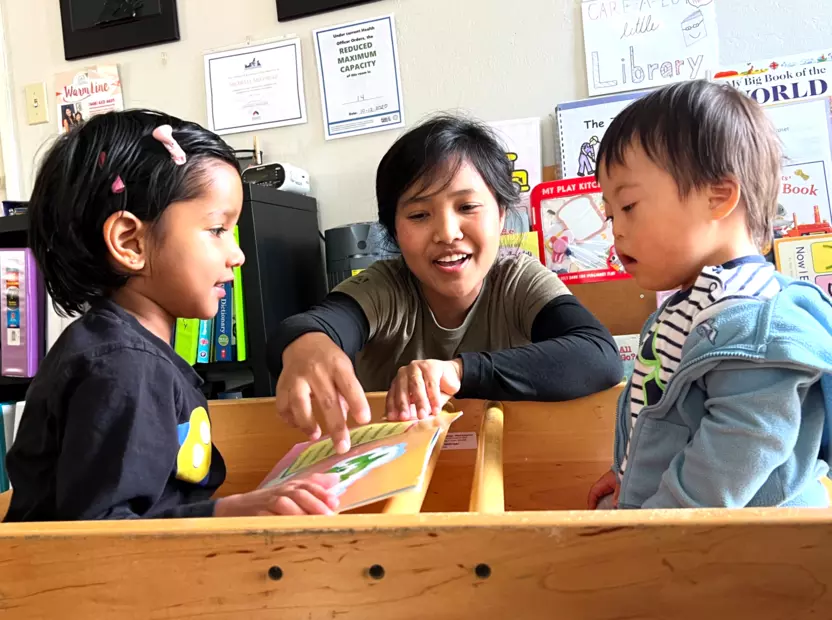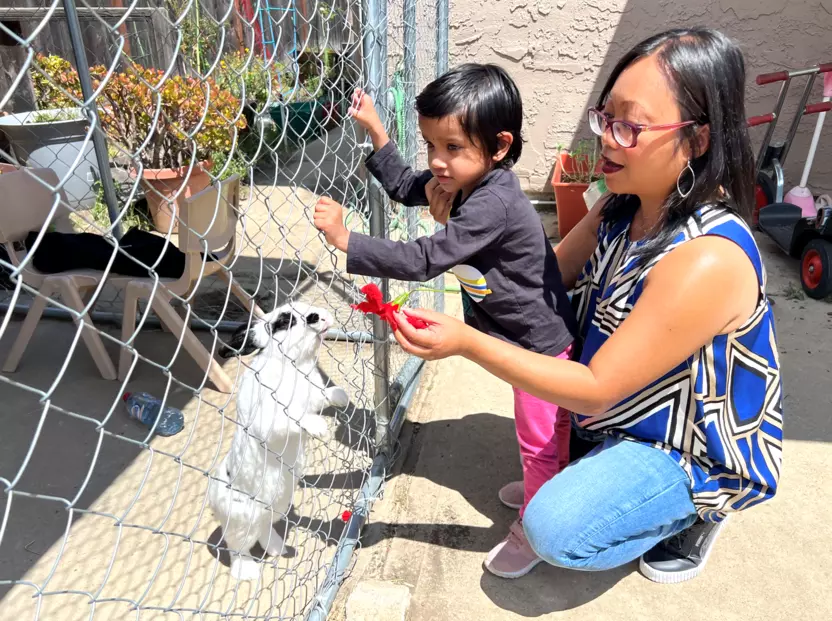County Partners with FIRST 5 to Spearhead Innovative Early Learning Apprenticeship to Improve Access to Childcare
The Early Learning Apprenticeship Initiative is an "earn and learn" program that gives participants the opportunity to work in a childcare setting while taking college classes to receive a childcare permit to enter the early learning profession
SANTA CLARA COUNTY, CALIF. – Two years ago, Michelle Melendez was thinking about closing her home-based childcare business and returning to her previous career in medicine.
Enrollment had plummeted during the COVID-19 pandemic, along with revenue. The future looked bleak.

Now, with the help of a new County-funded program to bolster the childcare and early childhood education workforce, she is feeling re-energized and ready to expand her business.
Melendez is enrolled in an Early Learning Apprenticeship Initiative that gives participants the opportunity to work in a childcare setting while taking college classes to receive a childcare permit to enter the early learning profession. The County has dedicated $10 million to the apprenticeship initiative and two other early learning workforce programs. Half the funding comes from the American Rescue Plan Act, the federal coronavirus relief bill.
The initiative, developed and administered by FIRST 5 of Santa Clara County, is an “earn and learn” workforce development program that is meant to strengthen early childhood education in the county by bringing new talent into the field. It is part of a broader County effort to improve access to high-quality childcare for residents, a top policy priority for the Board of Supervisors.
“We’ve reached a crisis level in terms of families being able to access childcare so that they are able to work and go to school comfortably and have their children, particularly babies and young children, in a safe and high-quality environment,” said Sarah Duffy, chief children’s officer for the County of Santa Clara. “The cost of living in Santa Clara County is so high – with housing and transportation, for example – that adding expensive childcare to that list of household expenses can be really stressful for a family. It’s critical that we add more childcare to the supply that’s affordable and accessible.”
Childcare industry hit hard by pandemic
The COVID-19 pandemic exacerbated the teacher shortage in early childhood care and education, said Heidi Emberling, executive of community impact for FIRST 5. Families kept their children at home, especially during the early days of stay-at-home orders, shrinking the demand for childcare workers.

“The impact of the COVID-19 pandemic on the availability of quality childcare in Santa Clara County cannot be overstated,” Emberling said. “More than 160 family childcare home providers and preschool classrooms were forced to close their doors temporarily or permanently. As preschool classrooms and home-based childcare settings are reopened, the field needs an infusion of skilled professionals to meet the County’s rising childcare needs.”
Susan Ellenberg, president of the County Board of Supervisors, has made childcare and early childhood education a focus of her tenure, recognizing their importance to children and families as well as the economy.
“Even before the pandemic, we’ve had this tension between the cost of providing high-quality, full-day childcare and what parents can afford to pay for that care, and where we’ve ended up is a very unhappy medium, with underpaid providers and parents who are severely burdened by the cost of childcare,” Ellenberg said. “Not only does quality early childcare and education support a child’s positive brain development during a period of rapid growth, but childcare is an essential resource for families while parents and caregivers are working or attending school to advance their own economic stability.”
The apprenticeship initiative is the result of a collaboration between the County, led by the Office of Children & Families Policy; FIRST 5, a local public entity that supports the healthy development of children in the critical first five years of their lives; childcare providers; Mission and De Anza colleges; and other community partners.
A source of inspiration
Participating in the apprenticeship initiative has been inspirational for Melendez, who operates a unique childcare business out of her home in the city of Santa Clara. She cares for both typical children and atypical children who have developmental disorders such as down syndrome.
“It’s helping me grow and learn new strategies to help the kids,” Melendez said of the program. “It’s been an awakening for me. My passion has grown stronger. I want to do this now more than ever.”

Melendez currently has six children in her program, split evenly between typical and atypical. She believes that bringing a diverse mix of children together at an early age has significant benefits. It eases the stigma of developmental disorders, makes atypical children feel welcomed and included, and broadens the perspectives of typical children.
It can be hard for parents of atypical children to find high-quality childcare, because of their special needs, Melendez said, and the apprenticeship initiative has deepened her conviction that she is providing a critical service to these families. She plans to renovate her home to enable her to expand her business and hire more assistants. She recently applied for a $200,000 grant from a new County program that has allocated $15 million to help childcare providers improve their facilities and expand operations.
Melendez has two assistants at the moment, both of whom are participating in the apprenticeship initiative, which began in 2022 after a year of community planning. The first cohort of the two-year apprenticeship pilot will finish the program this spring. Nearly 100 apprentices have enrolled in the program so far. All of them are currently employed in early childhood settings for their on-the-job training, and many intend to stay in the field after graduation.
(Because she already works in the childcare field, Melendez receives a monthly stipend from the program instead of participating in an apprenticeship.)
One of Melendez’s assistants, Sabina Thigeti Sangma, emigrated to the United States in 2020 from India, where she worked as a medical coder. The apprenticeship initiative has been “wonderful,” Sangma said, and is helping her make the transition to a career in childcare – she hopes to open her own home-based childcare business one day.
“I feel a lot more confident,” she said. “I knew what I was doing before but I didn’t know the theory behind it.”

The apprenticeship initiative enables participants to work for both home-based childcare businesses like Melendez’s and California State Preschool Programs that operate out of commercial spaces.
Gladys Monzon is an apprentice at Grail Family Services, a nonprofit that operates several preschool classrooms as well as providing essential resources and support to families with young children in East San José. The apprenticeship initiative is providing Monzon valuable on-the-job training, in addition to helping the Guatemala native improve her English-language skills.
“Gladys is amazing – she has great energy and loves to help children and their families,” said Carmen Lopez, who supervises the preschool where Gladys has worked 20 hours a week since the fall of 2022. “We have seen so much growth from her and are very proud of her.”
The apprenticeship initiative will help Monzon get the course credits she needs to achieve her next goal of being an assistant teacher. It will give her a strong foothold for her career, while families will benefit from having a well-educated, intuitive and compassionate person care for their children.
“The County of Santa Clara and FIRST 5 of Santa Clara County are committed to ensuring that our community has access to affordable, high-quality childcare,” said Ellenberg. “When you care for young children and their families, entire communities thrive.”